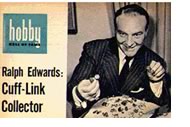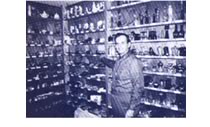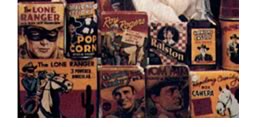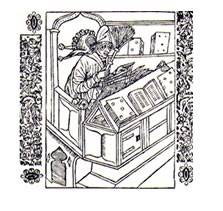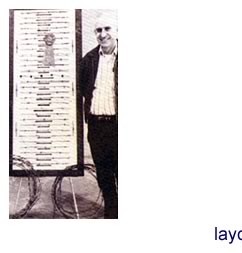THE COLLECTOR
To define the collector
Is there a typical collector
male/female
young/old - rich/poor
What motives ?
selfish/competitive
learning/research
When did it start ?
How did it develop ?
What will happen to it ?
bequest or sale or destruction
Can a corporation collect ?
Methods of collection
sources
rituals
the power of the hunt
finding versus dealers
THE COLLECTION
To define the collection.
What is collected and why ?
two dimensional
three dimensional
alive/dead
Limits to budgets ?
Is it to be complete ?
Methods of storage
Methods of classification
Private or Public
The Psychology of Collecting
Attempts at definition ;
"To define a collectable is a daunting task - one is tempted
to say it is anything people collect. - but as that would also embrace
old master paintings and property portfolios, it is far too vague.
Let us say that in general, for a subject to become collectable,
it usually possesses a tangible timeliness, a design that represents
an era. In addition, a collectable is generally affordable ; it
is sufficiently common for a collection to be attainable yet elusive
enough for the thrill of the hunt...." Pearce, op cit p.7
"What makes men collect modern art ? Acquisitiveness? Financial
speculation ? Social or cultural prestige ? Competition with other
collectors ? The pleasure of arousing envy ? The excitement of feeling
in the avant-garde? The satisfaction of annoying one's conservative
friends ? The noblesse oblige or richesse oblige to serve as a patron
of the arts for the beenfit of artists and the community ? Perhaps
even the love of art ?" Alfred H.Barr, Sale Catalogue, The
Collection of Twentieth Century Paintings and Sculpture Formed by
the late G.David Thompson of Pittsburgh, Parke-Bernet Galleries,
New York, 1966
What do we learn from collectors and collecting ? ; "To live
over other people's lives is nothing unless we live over their perceptions,
live over the growth , the change, the varying intensity of the
same - since it was by these things they themselves lived. " Henry
James, William Wetmore Story and his Friends 1903, quoted in Haskell
beneath.
The collector greets the objects ; "When I started to collect
avant-garde Russian art I found that no-one knew when it began or
ended or even which artists were really members of the movement...Gradually
as I began to understand my material I realised what I considered
essential for my collection. In addition to the ten or twelve names
suggested by others, I soon had forty five or more. And it is now
clear that by widening my scope, I have discovered for my purposes
larger purposes and meanings in the avant garde as a whole. ...There
is a special relationship between a collector and his collection.
The collection - at least for me - is an organism. I have often
felt the impulse to go to one of my paintings and caress it, give
it a smile, or somewhat like a Chukchi tribesman exhale smoke upon
it as a sign of love..." George Costakis, op.cit.
The habit starts ; "I had the collecting fever ever since I
was a child. When I was at Eton, we weren't allowed money - the
currency was cigarette cards - and when I left school, I had more
cards than all the other students together.." Peter Opie in
Cott, op.cit p.286.
Below Charles Sawyer of the California Barbed Wire Collectors .
"I grew up in a poor neighbourhood. As kids we used baseball
cards like money. If someone had something you wanted, you'd offer
him baseball cards for it. I was lucky because my father owned a
candy store. ..." Irving Lerner, collector quoted in Steve
Clark, The Complete Book of Baseball Cards ,Grosset
and Dunlap, New York 1977.
" I passed too through a Meccano period, adding box to box
each Chrsitmas, But I had little skill as an engineer....I collected
cigarette cards too and for a very brief period because somebody
gave me a special item for them, postmarks but these I found rather
abstract and there was no Stanley Gibbons catalogue to indicate
whether Penang was more valuable than Angmering. Crests and postcards
too had their appropriate albums...." Graham Greene, A
Sort of Life , Penguin 1979 , pp37-8.
"...if I was to save the wrappers, tins and bottles from every
product I bought, collectively they would represent a social history
of life in Britain." Robert Opie, Sweet Memories, Pavilion
London 1988
Showing the collection; "The owner of a collection who, no
matter how willingly he shows it, must yet show it more often than
he would like, cannot help becoming a little malicious, be he never
so mild and good-hearted. He sees total strangers making snap judgments
on objects familiar to him. ... Since this collection came into
my possession, I have met only one man who did me the honour of
believing that I know how to judge the worth of my own things. He
said to me ; I do not have much time; let me see the best, the most
remarkable and rarest object in each section. I thanked him and
said that he was the first to make such a request; and I trust he
did not regret his confidence in me; at least he seemed to go away
fully satisfied." Gage op cit p.44.
To store or to show ? "There may be two fundamental approaches
to the collecting of drawings, the first a print lover's and bibliophile's
approach in which drawings are kept in mats and boxes, systematically
arranged and and often concentrating on a single country or school.
The second approach devolves rather from a taste for paintings.
I am I think this second type - a painting collector manque if you
wish." Ian Woodner exhib catalogue,op.cit.
Public or Private ; [England] has no centralised dominant collection
despite all the acquisitions made by its private citizens. who
have naturally retained them for their private enjoyment. What
is the result ? The riches are scattered through every country
house; you have to travel in every county over hundreds of miles
to see these fragmented collections..." Quatremere de Quincy, 1796, quoted
in Gervase Jackson-Stops op.cit p. 50, in F.Haskell, "The British
as Collectors".
The frustration of failure; "David Salle brought out a painting
entitled Dusting Powder and Elliott remembers shouting "Oh
Oh I want it". Castelli however had the painting in mind for
someone else. Elliott recalls saying Leo I don't want any other
painting in the studio. He also recalls having chest pains. Four
days later Elliott checked into a Chicago hospital for quadruple
by pass surgery. `As they wheeled me into the operating room I kept
thinking I'll miss that painting, I'll miss that painting.'..." the
collector Gerald Elliott, in Benezra op.cit.
The satisfaction of anticipation "One day, years ago, I asked
him (the collector G.David Thompson] if he liked the work of Alberto
Burri, at that time rather little known even in Rome. His reply
was characteristic. He disappeared into a closet and emerged with
his arms full of painted-and-sewn burlap compositions. Twice more
he repeated this performance until there were a dozen or more works
by Burri standing around the walls." Alfred H.Barr, Sale Catalogue,
as quoted above.
Finding specimens ; "I began collecting labels about 16 years
ago. In my search for the unusual used and vintage clothing, I would
find a piece that was in some way distinctive but badly damaged.
At that point I'd take the label since it was the only salvageable
part of the garment." Thomas W.Oatman, op.cit
"I really don't know how I started to collect children's books.
It must have been twenty odd years ago that I thought it would be
fun to give my husband an illustrated book about Davy Crockett or
Daniel Boone. He was already engrossed in his hobby - which was
and is making reproduction Kentucky flintlock rifles. In some kind
of a vague way I must have been looking for an interest that would
keep me as busy and fascinated as he was...." Betsy Beinicke
Shirley, from her introduction to exhib.catal Read me a
Story - Show me a Book, Yale 1991.
" I have hunted butterflies in various climes and disguises;
as a pretty boy in knickerbockers and sailor cap; as a lanky cosmopolitan
expatriate in flannel bags and beret; as a fat hatless old man in
shorts.... Few things indeed have I known in the way of emotion
or appetite, ambition or achievement, that could surpass in richness
and strength the excitement of entomological exploration. ..." Vladimir
Nabokov, Speak Memory, Weidenfeld and Nicholson
London 1967.
Taking risks ; "..it's more fun to be where you're floating
outside your knowledge, where only your stomach tells you, or your
groin, that a photograph is good." Sam Wagstaff, collector,
in Pultz, op.cit
Finding a collection whole ; " The story of the Byrom collection
begins with the purchase of a house in Salford in August 1965...
In January 1969 when central heating was being installed, plumbers
made two unexpected discoveries. The chimney flues at the back were
found to be vast cavities... and under floorboards at the back of
the house one workman discovered a chamber with a flight of stone
steps disappearing into a brick wall.. Researches led me to the
Byrom collection of geometrical drawings.." Hancox op cit.
The naturalist Charles Waterton went to Germany to buy, Maratti's
portrait of Saint Catherine. "Waterton duly met the old man
and spent the whole day looking at his paintings. He learned to
his surprise that they were being offered for sale and decided to
buy the lot; 156 old masters. ... Dozens of canvasses joined the
museum of natural history which was slowly spreading through the
downstairs entrance hall and up the wide staircase." in Julia
Blackburn's Charles Waterton, Century London 1989
.
Inherited impulses to collect ; "They have what is probably
the greatest private collection of everything related to children
and childhood - toys, dolls, rocking horses, marbles, children's medicines,
clothes pegs, rattles, prams etc... The Opie's son Robert is probably the most
imp[ortant collector of packaging in the world..Their other son James is one
of the leading collectors of Britain's lead soldiers."
Specialities " Stuart Schneider and Roberta Etter are Halley's
Comet consultants based in Teaneck, New Jersey. They have published
articles on collectibles as well as a book on early fountain pens.
Another on antique flashlights is in the works. Schneider is a practising
attorney and Ms Etter the proprietor of a company that supplied
antique photographic items to collectors. Together they have formed
one of the largest collections of Halley's Comet memorabilia in
the world." Publishers puff on Etter and Schneider op.cit.
The search "Toy collecting is progressive - addictive. I was
overtaken by the mania. I became obsessed - a toy junkie, always
on some crazy search for the next toy fix. The greatest excitement
was in the search - running to flea markets, yard sales, tag sales
- checking out every antique shop and junk store - lingering long
hours at auctions only to see the toy go for an impossible price
- tracking down tips that might lead to a great find, sometimes,
maybe.... And now there's no end to it...." Ken Botto op.cit.
Of Thomas Nuttall, plant collector, " He worked away collecting
- not just plants, but rocks, fossils, many beetles and small animals,
including a new species of bat. He shipped them off by river boat,
but an old trouble that had long plagued American naturalists now
caught up with him. Indians rummaged through his boxes and drank
off the alcohol in which he preserved specimens " from J.Kastner, A Species of Eternity, Dutton New York 1969.
"If you looked carefully you would see 7 women's heads on the
picture. When I had almost finished, I knew that there was lacking
something. I went into the Eilenriede, the town forest of Hanover,
and found there half an engine of a child's train. I knew at once,
that belonged on the picture and put it at the right spot. But where
was the other half engine ? I got quite uncomfortable, because I
could not finish the picture without having the other half. I went
in the opposite direction of the Eilenriede into the Masch, not
a forest, but meadows. The first thing I saw was the second part
, the opposite side of the same children's engine. Of course I don't
know what was the reason that I at all needed the ruins of the children's
toy, but there is a reason, and this reason made the composition
of spiritual values correspondent to the composition in colours
and to the composition in lines and black and white. You must feel
then that the picture is ready and is a construction for distinguished
ladies, eminent ladies. "Kurt Schwitters, from John Elderfield, Schwitters,
Thames & Hudson 1987
Cataloguing the collection "And now for a short while I was
away from the crowd [around the deposed President's Palace] with
just one other person, a shy and absolutely thunderstruck Filipino.
We had found our way, we realised into the Marcoses' private rooms.
There was a library and my companion gazed in wonder at the leather
bound volumes while I admired the collection of art books all carefully
catalogued and with numbers on their spines. This was the reference
library for Imelda's worldwide collection of treasures. She must
have thumbed through them thinking : I'd like one of them, or I've
got a couple of them in New York, or That's in our London house." James
Fenton, reported in John Carey (ed), The Faber Book
of Reportage, Faber London 1987 p 685. And then there's
always her shoes.......
Influencing others ; "When I started to collect postcards,
gas stations, eateries, tourist cabins and motels caught my eye
most quickly. I felt a direct relationship and connection with these
subjects . They fed off one another. I collected other images that
aroused my heart and eyeballs, but there was a reason for the roadside
material. On an unconscious level I perceived it was because as
a child I didn't have the opportunity to travel by auto and to experience
road culture...Allen Wright told me I created a fad with the gas,
food and lodging category. He said, People are coming up to me at
post card meets and asking for dinners and motels and gas stations...
They never used to do that. You really did something with your paintings
and your book." John Baeder, op.cit.
"Ray Rawlings began to collect signatures, autograph letters
and manuscripts in 1930. Over the years he amassed some 30,000 items,
thus forming a collection that was widely recognised as the largest
of its type in private hands. Dubbed `the unofficial autographer
Royal" by one journalist, he did much to popularise the collecting
of autograph material..." Sale Catalogue,
Sotheby's, June 1980
Hierarchy and Collecting
"I went to Oxford to see Dr John Johnson's Sanctuary of Printing
at the Oxford University Press. It is a unique collection of print,
still being sorted, mounted and documented. The printed ephemera
ranges from fine early proclamations to penny tickets for lavatory
and cloakroom. As the Doctor said, `Nothing is too humble'. This
part of the collection was appropriately called Jobbing in the Service
of the Community. Dr.Johnson started his collection in 1925 when
he became Printer to the University...." John Lewis ,Printed
Ephemera ,Cowell's Ipswich 1962.
The Collector's Shop ;
"For over 25 years a sanctuary and a retreat of infinite pleasures,
through many fluctuating phases of my life... The strong sense of
the past through these experiences, enhanced by the physical atmosphere
of the shop - autographed photos and drawings on the walls, the
statue of Rachel, bric a brac, the stove, the back room (allowed
in there once or twice)... To the end it remained a `hole in the
wall' purposely and many were the well known authors, writers, theatrical
people etc. who frequented it for its quiet charm... While preserving
the amateur standing of the shop its dealer was actually tops in
the first edition field. " Joseph Cornell of The Sign
of the Sparrow, a collectors' shop at 42 Lexington Avenue,
New York, quoted in K.McShine, Joseph Cornell , exhib.catal., MOMA
NY 1990.
Rules ; Of the American collector Paul Mellon, "He rightly
looks at works of art in terms of the pleasure they give him and
his point of view accommodates whimsical proscriptions; neither
he nor Mrs.Mellon care for windmills and would not allow more than
three cows in pictures.Who can blame them ?" Denys Sutton,
in Wilmerding op.cit
The world's biggest collection of Avon Beauty Products. Display,
where and how ;"Sir Andrew Fountaine "decided to give
up his London house and move his collections to his country seat
of Narford in Norfolk. As well as pictures he owned " a large
number of coins and medals, and he also assembled many splendid
pieces of Italian majolica which, in the words of a scornful contemporary,
were' set out upon shelves like a shop'...." Haskell, in Jackson-Stops,
op.cit p.51.
"Ogden collected everything. Books filled his room to overflowing
- one visitor counted eighty-two family Bibles - and were arranged
if at all according to bizarre principles, such as the initial letters
of the titles spelling out a word or phrase, the significance of
which was often open to question. He also had quantities of musical
boxes, shoes (forty-two pairs by one count) clocks and mechanical
toys like the bird that sang only if asked to in basic English." from
Catherine Caulfield, The Emperor of The United States
of America and other magnificent British Eccentrics , Corgi
London 1981
Spasmodic collectors ;
"Six months later they had become archaeologists, and their
house looked like a museum. An old wooden beam stood in the vestibule.
Geological specimens cluttered up the staircase, and an enormous
chain stretched along the whole length of the corridor..... Just
inside one bumped into a stone trough (a Gallo-Roman sarcophagus),
then a display of ironmongery caught the eye. Against the opposite
wall a warming pan rose above two firedogs and a hearthplate representing
a monk fondling a shepherdess. On shelves all around stood torches,
locks, bolts screws. Shards of red tiles hid the floor. On a table
in the middle were exhibited the rarest curiosities: the frame of
a bonnet from Caux, two clay urns, some medals, a phial of opaline
glass. Over the back of a tapestry chair lay a triangle of lace.
A bit of chain mail adorned the partition to the right and below
it a halberd, a unique piece, was held horizontally on spikes." Flaubert, Bouvard et Pecuchet ,op.cit., p.103.
The Eighteenth Century Cabinet of Curiosities; Some of the contents
of Alexander Pope's Grotto," Several pieces of Crystal with
a brown Incrustation and a Mixture of Mundic from the Hartz mines
in Germany; a fine piece of Gold Ore from the Peruvian mines; Silver
ore from the Mines of Mexico; several pieces of silver ore from
Old Spain; some large pieces of gold clift from Mr.Cambridge in
Gloucestershire; Lead Ore, Copper Ore, white Spar, petrified wood,
Brazil pebbles, Egyptian pebbles and Bloodstones...." from
Francis Spufford,op.cit p.123, section Riches (Collections, Commodities
and Vanities); see G.Grigson, The Romantics , pp.
21-2, Don Saltero's Coffee House of Rarities.
A Silly Collection " A Collection of seven miniature volumes
containing drawings of six beetles, nutcrackers, clay and briar
pipes, horse brasses, scissors and candle snuffers, American wall
and shelf clocks and ancient musical instruments. The first drawn
by Marie Angel and the remainder by Pamela Fowler. Bound and chained
to a miniature wooden lectern which is encased in a cylinder, leather
covered and gold tooled. Executed at Froxfield by Roger Powell and
Peter G.Waters in 1959." from Ash and Lake, Bizarre
Books, Macmillan London 1985, quoting the British Museum
catalogue entry.
The Royal Library; " At the King's death [George III] the library
contained about 65,000 books and 450 manuscripts. It comprised
everything that an eighteenth century scholar could desire. Some idea of its
scope can be gathered from the editions of the Bible it contains.
There are at least two hundred, including a Polyglot Bible and
a Gutenberg printing; versions in Arabaic, Chaldaic, Greek, Hebrew,
Latin and Syriac; and the English versions from Coverdale and Tyndale.
There are translations in every European language, including Finnish,
Hungarian, Russian and Welsh as well as the commoner languages.
There is even a version in the language of the North American Indians." John
Brooke, King GeorgeIII, Constable London 1985,
pp 304-5.
The Twentieth Century Archive Movement ; "Every County or Shire
Hall contained a Muniment Room for housing the records of the Court
of County Sessions, the central administrative records of the county
, in the care of the Clerk of the Peace. At a time when the breakup
of the large country estate was often placing such collections under
the threat of dispersal or loss, it seemed a natural progression
to extend that care to other archives of historical significance
to the area.. Bedfordshire County Council set a precedent in the
years before the First World War which was quickly followed after
the War by others - Hertfordshire, Middlesex, Surrey, and so on
with ever increasing momentum. So it was that from this most modest
enough inspiration, by the enthusiasm of local pioneer archivists
that the county record offoce movement grew." ex.cat The Common
Chronicle.
"It was feared that if no measures were taken, the surviving
documentation of Freud's life would be dispersed all over the world
and most of it would be lost to future research. The need for a
Sigmund Freud archives was thus recognised. Subsequently the Library
of Congress agreed to accept as a donation, all documents collected
by the Archives, and to make them accessible to scholars after prearranged
dates, to be determined by the Archives." from Janet Malcolm,
op.cit.
The End of the Collection ; "My wish is that my drawings, my
Prints, my Curiosities, my Books - in a word, these things of art
which have been the joy of my life - shall not be consigned to the
cold tomb of a museum and subjected to the stupid glance of the
careless passerby; but I require that they shall all be dispersed
under the hammer of the Auctioneer, so that the pleasure which the
acquiring of each one of them has given me shall be given again,
in each case, to some inheritor of my own tastes." From the
will of Edmond de Goncourt, quoted on the sale catalogue of the
Library of John Quinn, see Reid op.cit.
"During the past week the British public has been admitted
to a spectacle of painful interest and gravely historical import.
One of the most splendid abodes of our almost regal aristocracy
has thrown open its portals to an endless succession of visitors,
who from morning to night have flowed in an uninterrupted stream
from room to room and floor to floor - not to enjoy the hospitality
of the Lord or to congratulate him on his countless treasures of
art, but to see an ancient family ruined , their palace marked for
destruction, and its contents scattered to the four winds of Heaven." The
Times in 1848 in the sale of Stowe and its contents, quoted in
Jackson-Stops, op.cit.pp.57/8
" The ring of living beauty drawn about our shores was a very
thin and fragile one. It had existed all those centuries solely
in consequence of the indifference, the blissful ignorance of man. These rock
basins, fringed by corallines, filled with still water almost as pellucid as
the upper air itself , thronged with beautiful sensitive forms of life - they
exist no longer; they are all profaned and emptied, and vulgarised. An army of
`collectors' has passed over them and ravaged every corner of them. The fairy
paradise has been violated, the exquisite product of centuries of natural selection
has been crushed under the rough paw of well meaning idle-minded curiosity. That
my father, himself so reverent , so conservative, had by the popularity of his
books acquired the direct responsibility for a calamity that he had never anticipated
became clear enough to himself before many years had passed, and cost him great
chagrin.' Edmund Gosse, Father and Son ,published 1907, writing
about his childhood in 1857.
"All the Renaissance was there [John Dee's Library]. Before
he left for France he made a catalogue of his library which is dated
September 6th 1583. Shortly after he left an angry crowd broke into
his house at Mortlake, smashed his scientific instruments and damaged
the library." [Dee] estimated the value at £2,000 and
said that that it took him about forty years to collect them "from
divers places beyond the seas and some by my great search and labour
here in England." from Frances Yates, The Theatre of
the World, RKP London 1987
A final collection. Of the Arts Bunker at Manod Quarry, "[The
Home Secretary] described two concrete bunkers inside caverns,
steel doors barring access, and the presence of a maintenance team on
the site....[Lord Jenkins asked in the Lords] Which works of art
are to be selected for location in the Arts Bunker in the event
of nuclear war.. and I ask whether provision is being made for
any living artists or Arts Council officials....{The Earl of Avon, Government
spokesman in the Lords answered that] it would not be in the public
interest to disclose details of security arrangements..." debate
12.11.81, from Duncan Campbell, War Plan UK Paladin
London 1983





